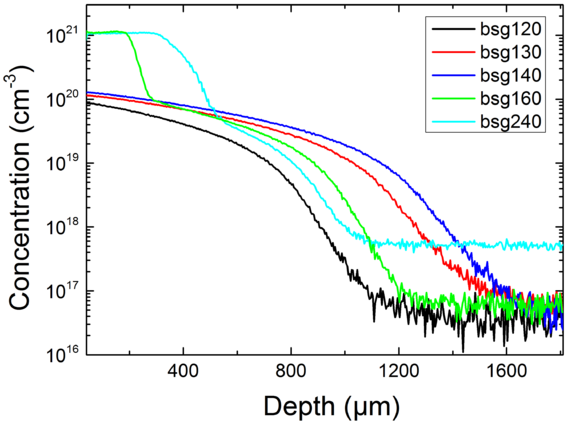Specific Process Knowledge/Thin film deposition/PECVD/Doping: Difference between revisions
No edit summary |
|||
| Line 32: | Line 32: | ||
|} | |} | ||
5 tests were made where only the B2H6 flow was changed (120sccm,130sccm,140sccm,160sccm,240sccm). All deposition times were 2 min (resulting in 440 nm Oxide). | 5 tests were made where only the B2H6 flow was changed for each deposition (120sccm,130sccm,140sccm,160sccm,240sccm). All deposition times were 2 min (resulting in 440 nm Oxide). | ||
The wafers were annealed in Anneal Oxide Furnace (C1) at 1000°C for 85 min to drive in the boron and the oxide was subsequently etched in BHF. The wafers were then analysed by SIMS and the results are shown in the figure below: | The wafers were annealed in Anneal Oxide Furnace (C1) at 1000°C for 85 min to drive in the boron and the oxide was subsequently etched in BHF. The wafers were then analysed by SIMS and the results are shown in the figure below: | ||
Revision as of 12:50, 1 December 2015
Feedback to this page: click here
THIS PAGE IS UNDER CONSTRUCTION
Boron-doping by use of BSG glass deposited in PECVD
Recipe
| Recipe name | SiH4 flow [sccm] | N2O flow [sccm] | N2 flow [sccm] | B2H6 flow [sccm] | PH3 flow [sccm] | Pressure [mTorr] | Power [W] | Description |
| 1PBSG | 17 | 1600 | 0 | 120, 130, 140, 160, 240 | 0 | 400 | 380 | BPSG glass for drive in boron in Silicon |
5 tests were made where only the B2H6 flow was changed for each deposition (120sccm,130sccm,140sccm,160sccm,240sccm). All deposition times were 2 min (resulting in 440 nm Oxide). The wafers were annealed in Anneal Oxide Furnace (C1) at 1000°C for 85 min to drive in the boron and the oxide was subsequently etched in BHF. The wafers were then analysed by SIMS and the results are shown in the figure below:

